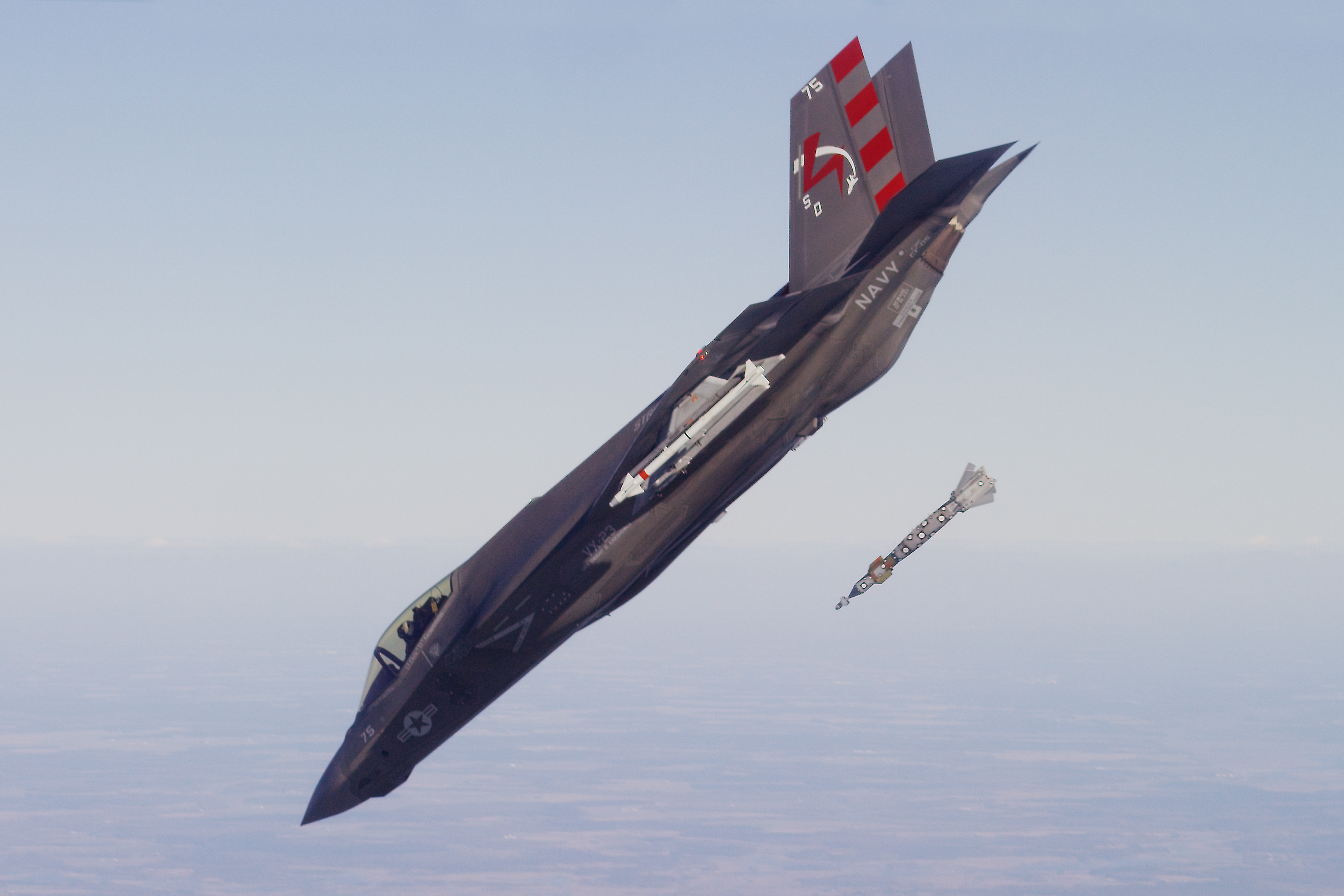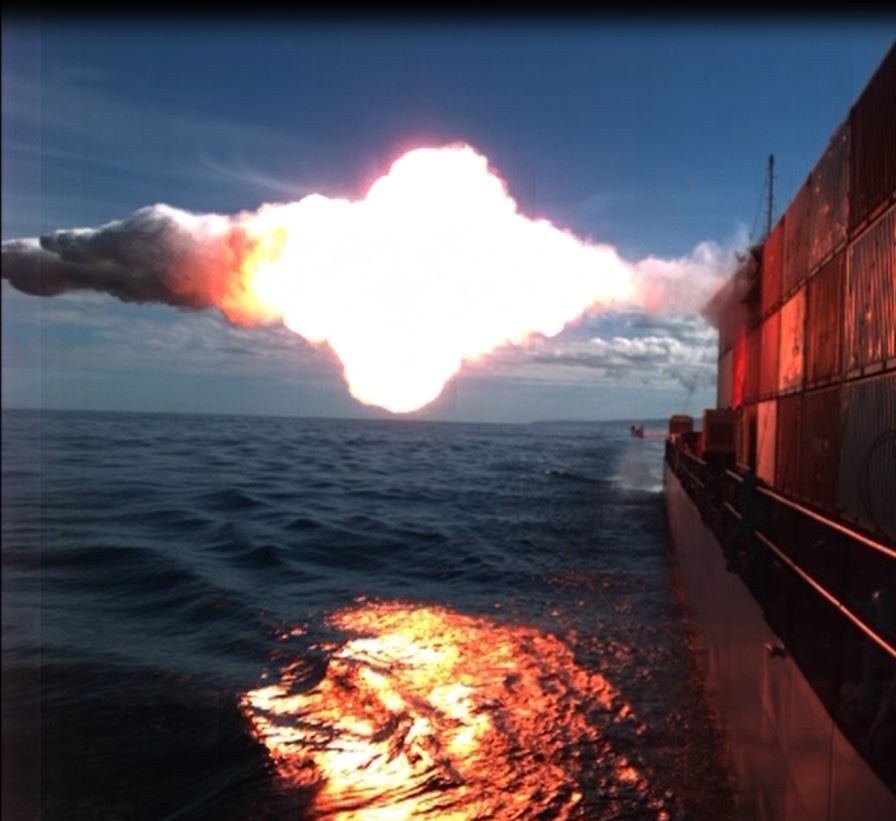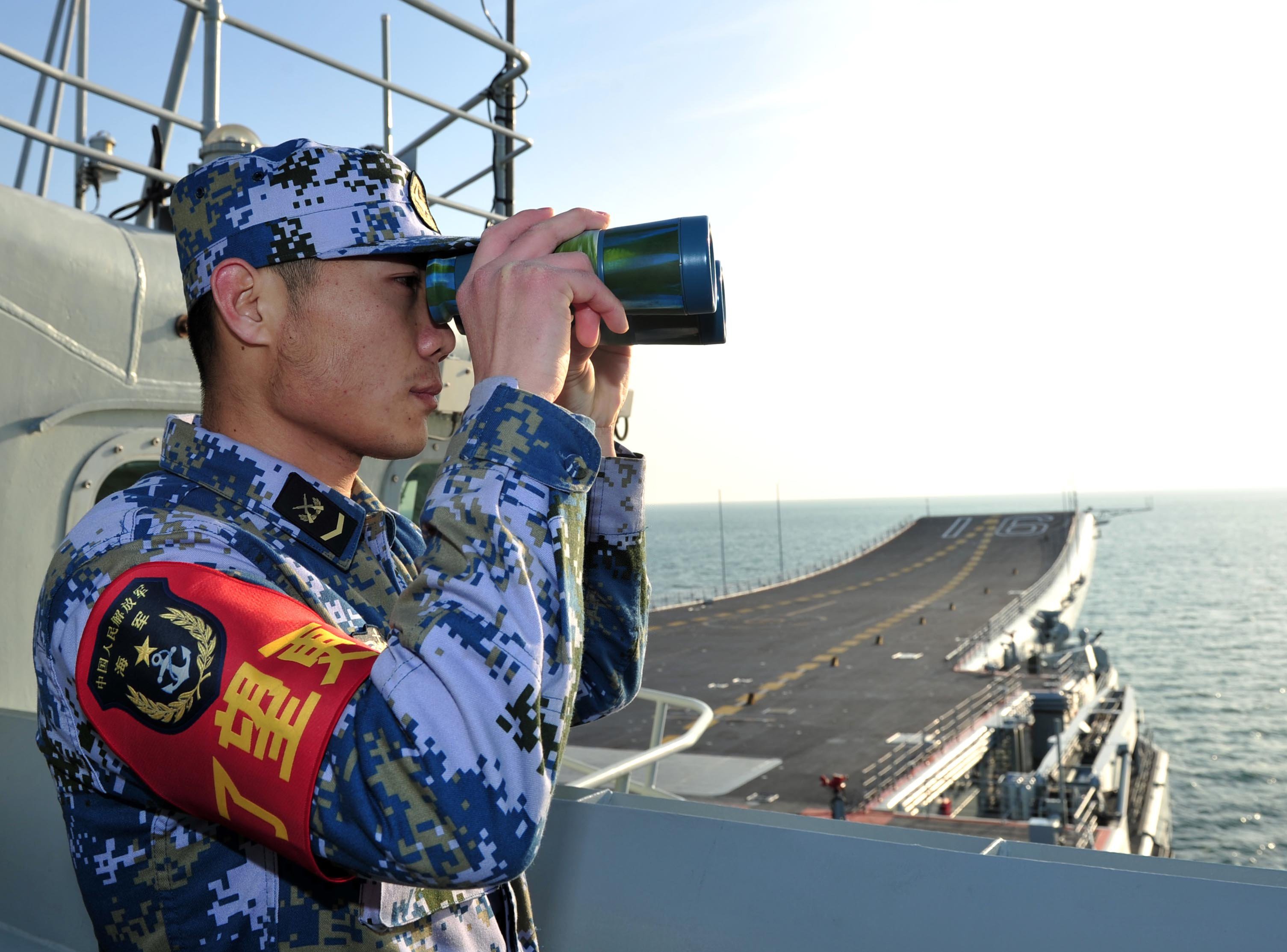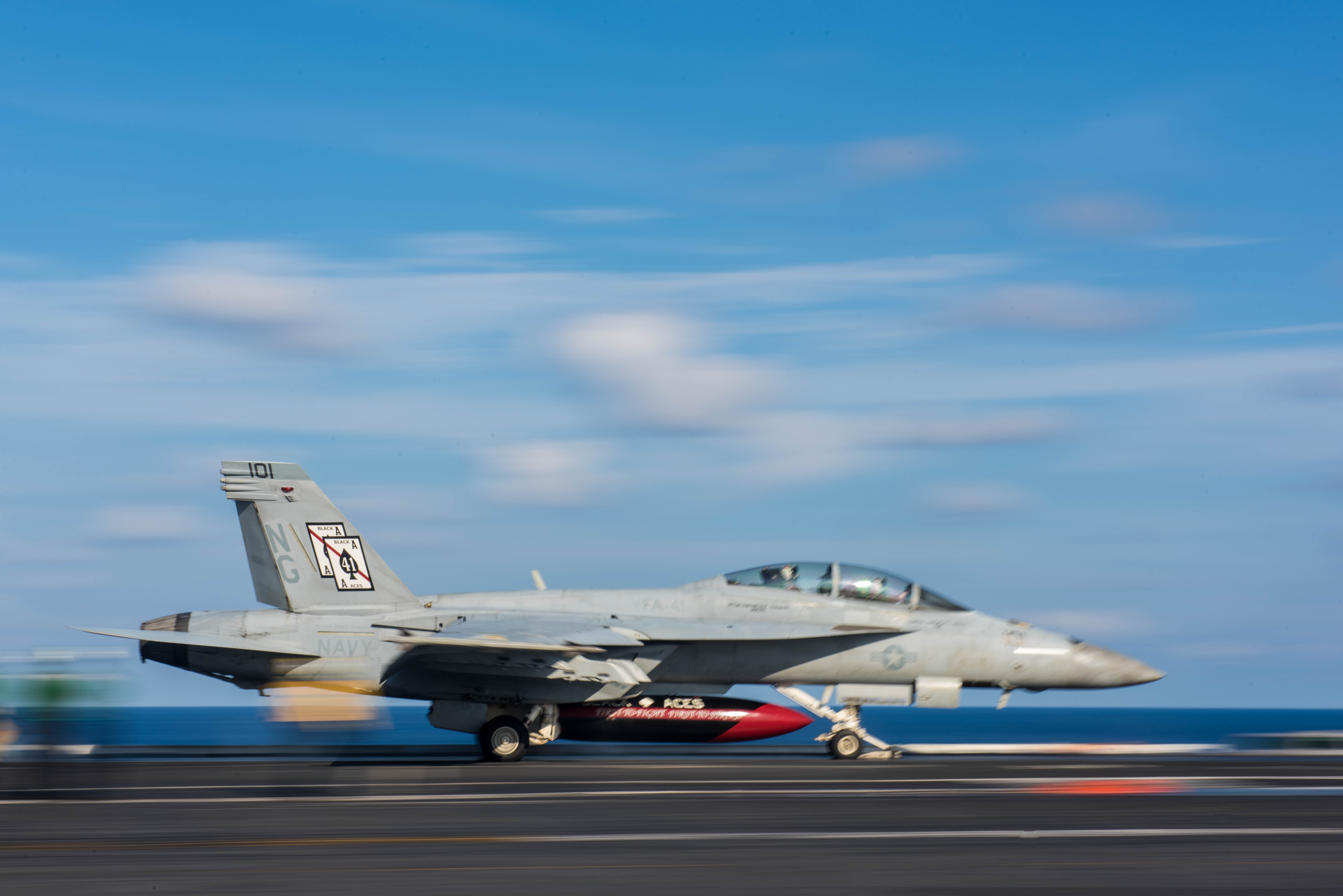
There has been a lively debate in recent years over whether the appurtenance of American military might—the supercarrier—will be rendered irrelevant, even obsolescent, by the burgeoning anti-access/area-denial (A2/AD) systems of the likes of China and Russia should war ever break out between them and Washington. This state of affairs is not helped by a glaring capability shortfall the U.S. Navy faces currently and in the foreseeable future: the lack of a carrier-based deep-strike aircraft due to the relatively short “legs” of its mainstay Boeing F/A-18E/F Super Hornet attack fighter as well as the upcoming Lockheed Martin F-35C Lightning II Joint Strike Fighter (JSF).
The Navy’s A2/AD Quandary
The Hornet has a combat radius of about 500 nautical miles and the JSF is only marginally better at 550 nm. The upshot is that their mother ships would have to operate well within the A2/AD envelope of a potential adversary such as China during a conflict. After all, the People’s Republic is said to possess anti-ship ballistic missiles (ASBMs) that can hit targets “exceeding 1,500km (810 nm) away.” To overcome that problem, defense experts have been exhorting the development of a long-range, stealthy unmanned aerial vehicle (UAV) capable of operating in high-threat environments—a highly chimerical notion considering the infancy of unmanned technology.

Seen in that light, the Navy’s recent rescindment of the Unmanned Carrier-Launched Airborne Surveillance and Strike aircraft program and the move to replace it with the Carrier-Based Aerial Refueling System initiative (which is now known as the MQ-25A Stingray) is hardly surprising. As one defense commentator noted, the talk about fully combat-capable carrier-based UAVs is purely theoretical as the lone stealthy aircraft on carrier decks in 2030 would realistically be only the F-35C.
Hence, the Navy being encumbered with a short-ranged Sunday Punch in the coming years, how best then could its much-vaulted supercarriers stay relevant in combat against near-peer adversaries? The aforementioned commentator argued that American carriers would do well to learn to “fight while under attack,” whereby advanced capabilities such as the Naval Integrated Fire Control-Counter Air network are fully exploited. That would certainly help—but only at the tactical level of war. At the doctrinal level, which is just as important if not more so, the panacea for the Navy’s A2/AD dilemma arguably lies in a reassessment of the current carrier strike group (CSG) concept of operations (CONOPS).
Re-examine the Role of the Flat-top

Key to that endeavor is the need to reassess the primacy of the aircraft carrier in U.S. naval doctrine. The vessel has been the “Queen of the Waves” for more than 70 years, having supplanted the big-gunned battleship in that role during World War II. It is worth noting that prior to 1942, American naval planners delineated the carrier to play a supporting role to the battle fleet: its planes were to scout for enemy battleships and attack them if possible so as to “soften” them for one’s own battle fleet to deliver the coup de grâce. However, during the course of WWII, the flat-top came to provide an order-of-magnitude upsurge in striking reach over the dreadnought. Ever since, the carrier has been the primus inter pares of warships with the surface fleet largely acting as its protective screen.
The advent of the long-range Tomahawk land-attack cruise missile (TLAM) and its deployment on the American cruiser-destroyer (CRUDES) force is on the cusp of upsetting the current carrier-surface ship dynamic with some commentators arguing that the relationship could come full circle since WWII if cruise-missile platforms were to overshadow carriers during an actual war. U.S. naval planners would do well to bear that in mind. After all, the latest variant of the TLAM can hit targets some 900 nm away—a considerable edge over the 500-odd nm range of U.S. carrier strike aircraft. While a CSG stationed 900 nm off China’s coast is probably still within Beijing’s ASBM deployment envelope, the carrier force could now operate at the outer limits of that envelope, and thus reduce its susceptibility to that uniquely Chinese weapon. Moreover, operating much farther out from the enemy coast reduces the threat posed by shorter-ranged platforms such as medium-attack planes, coastal craft and diesel-electric submarines.
In addition, the introduction of the Long-Range Anti-Ship Missile (LRASM) to the U.S. CRUDES fleet in the coming years could further enhance the survivability of American naval forces engaging a near-peer enemy. This is because the reach of the 500 nm-ranged weapon could be doubled by reducing the size of its 1000-pound warhead but without adversely decreasing its capabilities, as one eminent naval analyst has argued. Equipped with such a modified LRASM, any Navy force would operate even farther out from the enemy in an access-denial milieu.
All that being said, what is needed, therefore, is for the Navy’s leadership to consider—blasphemous as it may sound—a new concept of operations based on the notion that the large-deck carrier could be superseded by its cruise missile-armed consorts in a fight against near-peer opponents. This new CONOPS should see the designation of the CRUDES force as “first day(s) of war” platforms, with the carriers playing a supporting role during the opening blows of the conflict. To that end, the flat-top would carry out air superiority, scouting and other duties to facilitate the CRUDES force firing its TLAMs, as well as to enable the U.S. Air Force’s deep-strike missions. Indeed, the carrier would enter the fray only after the enemy’s metaphorical A2/AD “door” has been “kicked down” with the softening of enemy defenses by the missile shooters.
Seen in that light, the flat-top would no longer be the warp and woof of U.S. naval doctrine during a high-intensity conflict—at least during the initial stages; its escorts would, ironically. All in all, the carrier-surface ship dynamic in this concept of operations would be poignantly characterized by symbiosis more than ever as there would be an imperative for both platforms to mutually support one another during the different stages of a counter-A2/AD campaign.
Minimizing Detection is Also Key

Allied with this revised doctrinal role of carriers in the new CONOPS would be the need to minimize detection. To be sure, stressing the centrality of cruise missile-armed platforms would put the USN farther out of harm’s way in an access-denial environment, but the latter would still be within the engagement zone of the adversary’s long-range missiles and bombers. As such, there is a need to reduce enemy detection so as to improve the friendly force’s survivability in the area of operations.
The doyen of naval tactics, retired Navy Capt. Wayne P. Hughes, maintains in his groundbreaking book Fleet Tactics and Coastal Combat that being able to attack effectively first is the “great naval maxim of tactics,” adding that the principle should be regarded as the “very essence of tactical action for success in naval combat.” Looking at this argument from the other side of the coin, by reducing one’s detectability, the friendly force would be able to forestall the enemy getting in the first shot. And operating dispersed and under emission control (EMCON) would go a long way toward achieving that. The Navy should take a cue from two operating concepts it experimented with from the 1950s to the 1970s: Haystack and UPTIDE.
Simply put, the Haystack concept involved American warships operating dispersed with reduced communications and utilizing deception to mitigate the threat posed by Soviet bombers and submarines. Ditto UPTIDE (Unified Pacific Fleet Project for Tactical Improvement and Data Extraction), which incorporated lessons gleaned from the Haystack exercises. The two operating concepts from the height of the Cold War are highly relevant today as they show that the Navy was able to operate in a similar, non-permissive milieu with a reasonable degree of success.
To be sure, hiccups—especially in the realm of communications—surfaced during the Haystack and UPTIDE exercises, but that is hardly surprising considering that strict EMCON was practiced during those maneuvers. With assiduous practice and fine-tuning, however, mitigating those problems should be possible. All in all, any new American naval CONOPS concerning carriers should incorporate the insights derived from Haystack and UPTIDE and adapt them to suit 21st century realities. Doing so would no doubt stand the Navy in good stead in an A2/AD environment.
The Way Ahead

In sum, the concept of operations for the Navy as proposed offers a viable amelioration of its anti-access/area-denial conundrum. By stressing the centrality of platforms carrying long-range cruise missiles, it could operate its assets farther from harm’s way. And putting into practice operating concepts to reduce detection by the enemy would accentuate the survivability of friendly forces.
Armed forces are inherently conservative and dyed-in-the-wool entities, the Navy being no exception. In the face of emerging threats that could seriously undermine America’s hallowed large-deck carriers, Navy brass should do some serious evaluation and consider measures that could genuinely address the problem. That being said, the crux of the proposed CONOPS—the ostensibly heretical relegation of the carrier to play second fiddle to the cruiser/destroyer force—would undoubtedly ruffle many feathers in the naval aviation fraternity. Indeed, if the doctrinal role of the flat-top were really to be reassessed as suggested, the term “carrier strike group” would probably a bit of misnomer, given that the carrier would have to share the title of being Numero Uno with its consorts.
That begs the question: Would then we see the day when the pre-eminent American naval entity is a “missile strike group” rather than a carrier strike group? Given the current dominance of the “brown shoes” (aviation) community over that of the “black shoes” (surface fleet) in the Navy, it seems unlikely. However, it is noteworthy that a roughly similar situation—when black shoes held sway over brown ones—existed on the eve of WWII, and the rest, as they say, is history.




